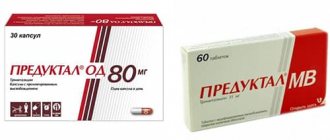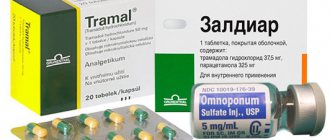Coldact flu plus sustained release capsules 10 pcs.
Registration Certificate Holder
Sun Pharmaceutical Industries (India)
Dosage form
Medicine - Coldact® FLU Plus (Coldact FLU Plus)
Description
Extended release capsules
1 cap.
phenylephrine hydrochloride 25 mg chlorphenamine (chlorpheniramine) maleate 8 mg paracetamol 200 mg
10 pieces. - blisters (1) - cardboard packs.
Indications
- symptomatic treatment of colds, flu, acute respiratory viral infections (fever, pain, rhinorrhea).
Contraindications for use
- hypersensitivity to any of the components included in the composition;
- severe atherosclerosis of the coronary arteries;
- arterial hypertension;
- diabetes;
- thyrotoxicosis;
- angle-closure glaucoma;
- severe diseases of the liver, kidneys, heart, bladder;
- peptic ulcer of the stomach and duodenum;
- pancreatic diseases;
- difficulty urinating with prostate adenoma;
- diseases of the blood system;
- deficiency of glucose-6-phosphate dehydrogenase;
- children's age up to 12 years.
With caution: congenital hyperbilirubinemia (Gilbert, Dubin-Johnson and Rotor syndromes), bronchial asthma and chronic obstructive pulmonary disease.
pharmachologic effect
Combined drug with prolonged action.
Chlorphenamine has an antiallergic effect, eliminates lacrimation, itching in the eyes and nose.
Paracetamol has an antipyretic and analgesic effect: it reduces the pain syndrome observed during colds - sore throat, headache, muscle and joint pain, and reduces high fever.
Phenylephrine has a vasoconstrictor effect - reduces swelling and hyperemia of the mucous membranes of the upper respiratory tract and paranasal sinuses.
Drug interactions
The risk of developing hematotoxic effects of paracetamol increases with simultaneous use of barbiturates, diphenine, carbamazepine, rifampicin, zidovudine and other inducers of microsomal liver enzymes.
Enhances the effects of sedatives, ethanol, and MAO inhibitors.
Antidepressants, phenothiazine derivatives, antiparkinsonian and antipsychotic drugs increase the risk of developing urinary retention, dry mouth, and constipation.
GCS increase the risk of developing glaucoma.
Paracetamol reduces the effectiveness of uricosuric drugs.
Chlorphenamine combined with furazolidone can lead to hypertensive crisis, agitation, and hyperrexia.
Tricyclic antidepressants enhance the adrenomimetic effect of phenylephrine; simultaneous administration of halothane increases the risk of developing ventricular arrhythmia.
Reduces the hypotensive effect of guanethidine, which in turn enhances the alpha-adrenergic stimulating activity of phenylephrine.
Dosage regimen
Adults and children over 12 years old - 1 capsule every 12 hours for 3-5 days.
Duration of use as an antipyretic is no more than 3 days; as a pain reliever - no more than 5 days.
Overdose
Symptoms caused by paracetamol appear after taking more than 10-15 g: pallor of the skin, decreased appetite, nausea, vomiting, hepatonecrosis, increased activity of liver transaminases, increased prothrombin time.
Treatment: gastric lavage in the first 6 hours, administration of SH-group donors and precursors for the synthesis of glutathione-methionine 8-9 hours after an overdose and N-acetylcysteine after 12 hours. In case of accidental overdose, you should immediately consult a doctor, regardless of what is noted -either symptoms of overdose or not.
Side effect
Increased blood pressure, tachycardia, drowsiness, difficulty falling asleep, dizziness, increased excitability, dry mucous membranes, mydriasis, accommodation paresis, increased intraocular pressure, loss of appetite, nausea, epigastric pain, anemia.
Very rare: urinary retention, allergic reactions (skin rash, itching, urticaria, angioedema).
Rarely: anemia, thrombocytopenia, leukemia, agranulocytosis.
With long-term use in high doses, hepatotoxic and nephrotic effects are possible.
special instructions
Without a doctor's instructions, the drug should not be used by patients undergoing treatment with other medications, in particular MAO inhibitors. If, despite taking the drug, the disease is accompanied by ongoing fever or repeated increases in temperature are observed, you should consult a doctor. Do not take with alcohol or combine with other drugs containing paracetamol. When using Coldact Flu Plus, it is not advisable to use sleeping pills, tranquilizers and other psychotropic drugs.
Distorts laboratory test results in the quantitative determination of glucose and uric acid in plasma. In case of long-term treatment, peripheral blood parameters and the functional state of the liver are monitored.
Impact on the ability to drive vehicles and machinery
During the treatment period, it is necessary to refrain from driving vehicles and engaging in potentially hazardous activities that require increased concentration and speed of psychomotor reactions.
Storage conditions
Store in a dry place at a temperature not exceeding 25°C. Keep out of the reach of children.
Best before date
Shelf life: 2 years. Do not use after expiration date.
Use during pregnancy and breastfeeding
Restrictions during pregnancy - Contraindicated. Restrictions during breastfeeding - Contraindicated. Coldact Flu Plus capsules are not recommended for use during pregnancy and lactation.
Use for renal impairment
Restrictions for impaired renal function - Contraindicated. Contraindicated: severe kidney disease.
Use for liver dysfunction
Restrictions for liver dysfunction - Contraindicated. Contraindicated: severe liver disease.
Use in children
Restrictions for children - Contraindicated. Contraindicated for children under 12 years of age.
Terms of sale
The drug is approved for use as a means of OTC.
Codelac Neo syrup: instructions for use
Where can I buy
Registration number : LP-001847
Trade name of the drug : Codelac® Neo
International nonproprietary name: butamirate
Dosage form : syrup.
Composition per 5 ml
Active substance: butamirate citrate – 7.5 mg;
Excipients: sorbitol (Neosorb 70/70 B, sorbitol syrup) 2025.0 mg, glycerol (glycerol) 1450.0 mg, ethanol 95% (ethyl alcohol 95%) 12.69 mg, sodium saccharinate 3.0 mg, benzoin acid 5.75 mg, vanillin 3.0 mg, sodium hydroxide solution 30% 1.55 mg, purified water up to 5 ml.
Description
Colorless liquid with a vanilla odor.
Pharmacotherapeutic group: centrally acting antitussive.
ATX code: R05DB13
Pharmacological properties Pharmacodynamics
A non-opioid antitussive agent that has a direct effect on the cough center. It has an antitussive, expectorant, moderate bronchodilator and anti-inflammatory effect, improves spirometry (reduces airway resistance) and blood oxygenation.
Pharmacokinetics
Suction
After oral administration, butamirate is quickly and completely absorbed from the gastrointestinal tract. After taking 150 mg of butamirate, the maximum concentration of the main metabolite (2-phenylbutyric acid) in the blood plasma is reached after approximately 1.5 hours and is 6.4 mcg/ml.
Distribution and metabolism
Hydrolysis of butamirate initially to 2-phenylbutyric acid and diethylaminoethoxyethanol begins in the blood. These metabolites also have antitussive activity and, like butamirate, are highly (about 95%) bound to plasma proteins, resulting in their long half-life. 2-phenylbutyric acid is partially metabolized by hydroxylation.
When taking the drug again, no accumulation is observed.
Removal
The half-life of butamirate is 6 hours. Metabolites are excreted mainly by the kidneys. Moreover, 2-phenylbutyric acid is mainly excreted in the form associated with glucuronic acid.
Indications for use
Dry cough of any etiology, including whooping cough; to suppress cough in the preoperative and postoperative period, during surgical interventions and bronchoscopy.
Contraindications
Hypersensitivity to the components of the drug, fructose intolerance, pregnancy (first trimester), breastfeeding period. Children under 3 years of age.
Use of the drug during pregnancy and breastfeeding
There is no data on the safety of the drug during pregnancy and its passage through the placental barrier. The use of the drug in the first trimester of pregnancy is contraindicated. In the second and third trimesters of pregnancy, the use of the drug is possible taking into account the ratio of benefits to the mother and potential risk to the fetus.
The penetration of the drug into breast milk has not been studied, therefore the use of the drug during breastfeeding is not recommended.
Directions for use and doses
The syrup should be taken orally before meals.
The syrup is prescribed to children: aged 3 to 6 years - 5 ml 3 times a day; from 6 to 12 years - 10 ml 3 times a day; 12 years and older - 15 ml 3 times a day. Adults – 15 ml 4 times a day.
When taking the drug, you should use a measuring device.
If the cough persists more than 5 days after starting treatment, you should consult a doctor.
Side effect
From the central nervous system: dizziness, which goes away when the drug is discontinued or the dose is reduced; drowsiness.
From the digestive system: nausea, diarrhea. Allergic reactions: skin rash, itching.
Other: exanthema.
Overdose
Symptoms: nausea, vomiting, drowsiness, diarrhea, dizziness, decreased blood pressure, impaired coordination of movements.
Treatment: activated carbon, saline laxatives, symptomatic therapy (according to indications).
Interaction with other drugs
No drug interactions have been reported for butamirate. During treatment with the drug, it is not recommended to drink alcoholic beverages, as well as drugs that depress the central nervous system (hypnotics, antipsychotics, tranquilizers and other drugs).
special instructions
The syrup contains sodium saccharinate and sorbitol as sweeteners, so it can be used by patients with diabetes.
There is a danger when using the drug in patients with a tendency to develop drug dependence, with liver diseases, alcoholism, epilepsy, and brain diseases.
Impact on the ability to drive a car and operate machinery
It is recommended to refrain from driving vehicles and engaging in other potentially hazardous activities that require increased concentration and speed of psychomotor reactions, as the drug can cause dizziness.
Release form
Syrup 1.5 mg/ml.
100 and 200 ml in dark (amber) glass bottles. One bottle, along with instructions for use and a measuring spoon, is placed in a cardboard pack.
Storage conditions
Store at a temperature not exceeding 25 oC. Keep out of the reach of children.
Best before date
2 years. Do not use after the expiration date stated on the packaging.
Conditions for dispensing from pharmacies
Over the counter.
Name and address of the manufacturer/organization receiving claims
OJSC Pharmstandard-Leksredstva, 305022, Russia, Kursk, st. 2nd Aggregatnaya, 1a/18, tel./fax www.pharmstd.ru


